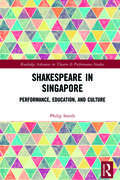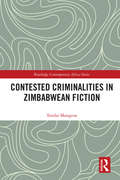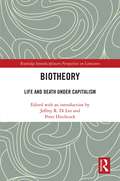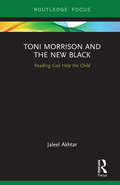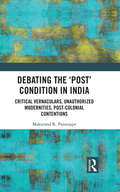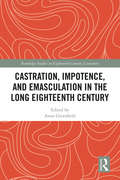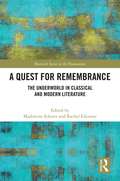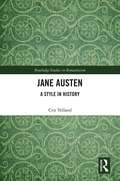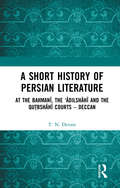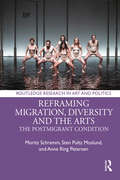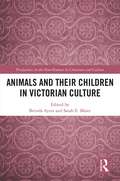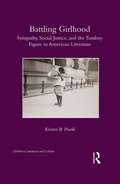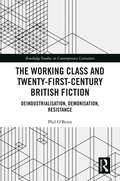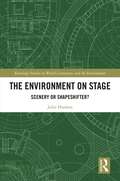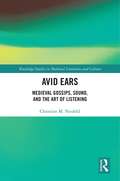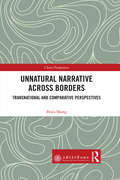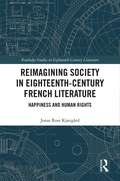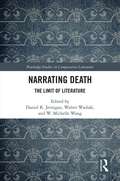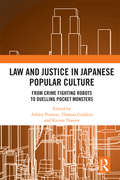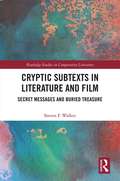- Table View
- List View
Shakespeare in Singapore: Performance, Education, and Culture (Routledge Advances in Theatre & Performance Studies)
by Philip SmithShakespeare in Singapore provides the first detailed and sustained study of the role of Shakespeare in Singaporean theatre, education, and culture. This book tracks the role and development of Shakespeare in education from the founding of modern Singapore to the present day, drawing on sources such as government and school records, the entire span of Singapore's newspaper archives, playbills, interviews with educators and theatre professionals, and existing academic sources. By uniting the critical interest in Singaporean theatre with the substantial body of scholarship that concerns global Shakespeare, the author overs a broad, yet in-depth, exploration of the ways in which Singaporean approaches to Shakespeare have been shaped by, and respond to, cultural work going on elsewhere in Asia. A vital read for all students and scholars of Shakespeare, Shakespeare in Singapore offers a unique examination of the cultural impact of Shakespeare, beyond its usual footing in the Western world.
A Philosophy of Autobiography: Body & Text
by Aakash Singh RathoreThis book offers intimate readings of a diverse range of global autobiographical literature with an emphasis on the (re)presentation of the physical body. The twelve texts discussed here include philosophical autobiography (Nietzsche), autobiographies of self-experimentation (Gandhi, Mishima, Warhol), literary autobiography (Hemingway, Das) as well as other genres of autobiography, including the graphic novel (Spiegelman, Satrapi), as also documentations of tragedy and injustice and subsequent spiritual overcoming (Ambedkar, Pawar, Angelou, Wiesel). In exploring different literary forms and orientations of the autobiographies, the work remains constantly attuned to the physical body, a focus generally absent from literary criticism and philosophy or study of leading historical personages, with the exception of patches within phenomenological philosophy and feminism. The book delves into how the authors treated here deal with the flesh through their autobiographical writing and in what way they embody the essential relationship between flesh, spirit and word. It analyses some seminal texts such as Ecce Homo, The Story of My Experiments with Truth, Waiting for a Visa, I Know Why the Caged Bird Sings, A Moveable Feast, Night, Baluta, My Story, Sun and Steel, The Philosophy of Andy Warhol, MAUS and Persepolis. Lucid, bold and authoritative, this book will be of great interest to scholars and researchers of philosophy, literature, gender studies, political philosophy, media and popular culture, social exclusion, and race and discrimination studies.
The Ethical Vision of George Eliot: Communion and Difference (Among the Victorians and Modernists)
by Thomas AlbrechtThe Ethical Vision of George Eliot is one of the first monographs devoted entirely to the ethical thought of George Eliot, a profoundly significant, influential figure not only in nineteenth-century English and European literature, nineteenth-century women’s writing, the history of the novel, and Victorian intellectual culture, but also in the field of literary ethics. Ethics are a predominant theme in Eliot’s fictional and non-fictional writings. Her ethical insights and ideas are a defining element of her greatness as an artist and novelist. Through meticulous close readings of Eliot’s fiction, essays, and letters, The Ethical Vision of George Eliot presents an original, complex definition of her ethical vision as she developed it over the course of her career. It examines major novels like Adam Bede, Middlemarch, and Daniel Deronda; many of Eliot’s most significant essays; and devotes two entire chapters to Eliot’s final book Impressions of Theophrastus Such, an idiosyncratic collection of character sketches that Eliot scholars have heretofore generally overlooked or ignored. The Ethical Vision of George Eliot demonstrates that Eliot defined her ethical vision alternately in terms of revealing and strengthening a fundamental human communion that links us to other persons, however different and remote from ourselves; and in terms of recognizing and respecting the otherness of other persons, and of the universe more generally, from ourselves. Over the course of her career, Eliot increasingly transitions from the former towards the latter imperative, but she also considerably complicates her conception of otherness, and of what it means to be ethically responsible to it.
Contested Criminalities in Zimbabwean Fiction (Routledge Contemporary Africa)
by Tendai MangenaThis book addresses the ways in which writers deploy the trope of contested criminality to expose Zimbabwe's socially and politically oppressive cultures in a wide range of novels and short stories published in English between 1994 and 2016. Some of the most influential authors that are examined in this book are Yvonne Vera, Petina Gappah, NoViolet Bulawayo, Brian Chikwava, Christopher Mlalazi, Tendai Huchu and Virginia Phiri. The author uses the Zimbabwean experience to engage with critical issues facing the African continent and the world, providing a thoughtful reading of contemporary debates on illegal migration, homophobia, state criminality and gender inequalities. The thematic focus of the book represents a departure from what Schulze-Engler notes elsewhere as postcolonial discourse’s habit of suggesting that the legacies of colonialism and the predominance of the ‘global North’ are responsible for injustice in the Global South. Using the context of Zimbabwe, it is shown that colonialism is not the only image of violence and injustice, but that there are other forms of injustice that are of local origin. Throughout the book, it is argued that in speaking about contested criminalities, writers call attention to the fact that laws are violated, some laws are unjust and some crimes are henceforth justified. In this sense crime, (in)justice and the law are portrayed as unstable concepts.
Excavating Modernity: Physical, Temporal and Psychological Strata in Literature, 1900-1930 (Studies for the International Society for Cultural History)
by Eleanor Dobson Gemma BanksThis book scrutinizes physical, temporal and psychological strata across early twentieth-century literature, focusing on geological and archaeological tropes and conceptions of the stratified psyche. The essays explore psychological perceptions, from practices of envisioning that mimic looking at a painting, photograph or projected light, to the comprehension of the palimpsestic complexities of language, memory and time. This collection is the first to see early twentieth-century physical, temporal and psychological strata interact across a range of canonical and popular authors, working in a variety of genres, from theatre to ghost stories, children’s literature to modernist magna opera.
Biotheory: Life and Death under Capitalism (Routledge Interdisciplinary Perspectives on Literature)
by Schulz Jeffrey R. Di Leo Peter HitchcockForged at the intersection of intense interest in the pertinence and uses of biopolitics and biopower, this volume analyzes theoretical and practical paradigms for understanding and challenging the socioeconomic determinations of life and death in contemporary capitalism. Its contributors offer a series of trenchant interdisciplinary critiques, each one taking on both the specific dimensions of biopolitics and the deeper genealogies of cultural logic and structure that crucially inform its impress. New ways to think about biopolitics as an explanatory model are offered, and the subject of bios (life, ways of life) itself is taken into innovative theoretical possibilities. On the one hand, biopolitics is addressed in terms of its contributions to forms and divisions of knowledge; on the other, its capacity for reformulation is assessed before the most pressing concerns of contemporary living. It is a must read for anyone concerned with the study of bios in its theoretical profusions.
Toni Morrison and the New Black: Reading God Help the Child
by Jaleel AkhtarToni Morrison and the New Black examines how Morrison explores the concept of the new black in the context of post-soul, post-black and post-racial discourses. Morrison evolves the new black as symbolic of unprecedented black success in all walks of life, from politics to the media, business and beyond.The author's work shows how the new black reaffirms the possibility of upward mobility and success, and stands as testimony to the American Dream that anyone can achieve material success provided they work hard enough for it.
Debating the 'Post' Condition in India: Critical Vernaculars, Unauthorized Modernities, Post-Colonial Contentions
by Makarand R. ParanjapeHow was the post-modernist project contested, subverted and assimilated in India? This book offers a personal account and an intellectual history of its reception and response. Tracing independent India’s engagement with Western critical theory, Paranjape outlines both its past and ‘post’. The book explores the discursive trajectories of post-modernism, post-colonialism, post-Marxism, post-nationalism, post-feminism, post-secularism — the relations that mediate them — as well as interprets, in the light of these discussions, core tenets of Indian philosophical thought. Paranjape argues that India’s response to the modernist project is neither submission, willing or reluctant, nor repudiation, intentional or forced; rather India’s ‘modernity’ is ‘unauthorized’, different, subversive, alter-native and alter-modern. The book makes the case for a new integrative hermeneutics, the idea of the indigenous ‘critical vernacular’, and presents a radical shift in the understanding of svaraj (beyond decolonisation and nationalism) to express transformations at both personal and political levels. A key intervention in Indian critical theory, this volume will interest researchers and scholars of literature, philosophy, political theory, culture studies and postcolonial studies.
Castration, Impotence, and Emasculation in the Long Eighteenth Century (Routledge Studies in Eighteenth-Century Literature)
by Anne Leah GreenfieldThis essay collection examines one of the most fearsome, fascinating, and hotly-discussed topics of the long eighteenth century: masculinity compromised. During this timespan, there was hardly a literary or artistic genre that did not feature unmanning regularly and prominently: from harrowing tales of castrations in medical treatises, to emasculated husbands in stage comedies, to sympathetic and powerful eunuchs in prose fiction, to glorious operatic performances by castrati in Italy, to humorous depictions in caricature and satirical paintings, to fearsome descriptions of Eastern eunuchs in travel narratives, to foolish and impotent old men who became a mainstay in drama. Not only does this unprecedented study of unmanning (in all of its varied forms) illustrate the sheer prevalence of a trope that featured prominently across literary and artistic genres, but it also demonstrates the ways diminished masculinity reflected some of the most strongly-held anxieties, interests, and values of eighteenth-century Britons.
A Quest for Remembrance: The Underworld in Classical and Modern Literature (Warwick Series in the Humanities)
by Rachel Falconer Madeleine SchererA Quest for Remembrance: The Underworld in Classical and Modern literature brings together a range of arguments exploring connections between the descent into the underworld, also known as katabasis, and various forms of memory. Its chapters investigate the uses of the descent topos both in antiquity and in the reception of classical literature in the nineteenth to twenty-first centuries. In the process, the volume explores how the hero’s quest into the underworld engages with the theme of recovering memories from the past. At the same time, we aim to foreground how the narrative format itself is concerned with forms of commemoration ranging from trans-cultural memory, remembering the literary and intellectual canon, to commemorating important historical events that might otherwise be forgotten. Through highlighting this duality this collection aims to introduce the descent narrative as its own literary genre, a ‘memorious genre’ related to but distinct from the quest narrative.
Jane Austen: A Style in History (Routledge Studies in Romanticism)
by Cris YellandFrom 1809 until just before her death, Jane Austen lived in a small, all-female household at Chawton, where reading aloud was the evening's entertainment and a crucial factor in the way Austen formed and modified her writing. This book looks in detail at Jane Austen's style. It discusses her characteristic abstract vocabulary, her adaptations of Johnsonian syntax and how she came to make her most important contribution to the technique of fiction, free indirect discourse. The book draws extensively on historical sources, especially the work of writers like Johnson, Hugh Blair and Thomas Sheridan, and analyses how Austen negotiated her path between the fundamentally masculine concerns of eighteenth-century prescriptivists and her own situation of a female writer reading her work aloud to a female audience.
A Short History of Persian Literature: At the Bahmanī, the ‘Ādilshāhī and the Qutbshāhī Courts – Deccan
by T. N. DevareThis is a seminal book, first published in 1961. Over the past six decades, T.N. Devare's work has been widely recognised as a pioneering study to re-discover the glorious heritage of Persian in the Deccan, following the first comprehensive and critical survey completed by the author of Persian manuscript sources and literary works scattered across numerous libraries, archives and repositories in India and abroad.The book convincingly argues that, the Deccan’s multilingual and multi-religious traditions shaped the evolution of Indo-Persian and produced over nearly four centuries, a distinct literary and cultural world marked by a syncretic character which defied social, political or religious boundaries. The author also makes the case for collaboration between Persian and the regional languages of India, particularly Marathi. It is the rich legacy of Persian in the Deccan Courts with their vast treasures of literature that is preserved in Dr Devare’s work.The book has been regarded and continues to remain a foundational text for studying the Deccan, be it in the field of history, literature or culture.Please note: Taylor & Francis does not sell or distribute the Hardback in India, Pakistan, Nepal, Bhutan, Bangladesh and Sri Lanka
Reframing Migration, Diversity and the Arts: The Postmigrant Condition (Routledge Research in Art and Politics)
by Moritz Schramm Sten Pultz Moslund Anne Ring Petersen Mirjam Gebauer Hans Christian Post Sabrina Vitting-Seerup Frauke WiegandThis book offers a compelling study of contemporary developments in European migration studies and the representation of migration in the arts and cultural institutions. It introduces scholars and students to the new concept of ‘postmigration’, offering a review of the origin of the concept (in Berlin) and how it has taken on a variety of meanings and works in different ways within different national, cultural and disciplinary contexts. The authors explore postmigrant theory in relation to the visual arts, theater, film and literature as well as the representation of migration and cultural diversity in cultural institutions, offering case studies of postmigrant analyses of contemporary works of art from Europe (mainly Denmark, Germany and Great Britain).
Animals and Their Children in Victorian Culture (Perspectives on the Non-Human in Literature and Culture)
by Brenda Ayres Sarah Elizabeth MaierWhether a secularized morality, biblical worldview, or unstated set of mores, the Victorian period can and always will be distinguished from those before and after for its pervasive sense of the "proper way" of thinking, speaking, doing, and acting. Animals in literature taught Victorian children how to be behave. If you are a postmodern posthumanist, you might argue, "But the animals in literature did not write their own accounts." Animal characters may be the creations of writers’ imagination, but animals did and do exist in their own right, as did and do humans. The original essays in Animals and Their Children in Victorian explore the representation of animals in children’s literature by resisting an anthropomorphized perception of them. Instead of focusing on the domestication of animals, this book analyzes how animals in literature "civilize" children, teaching them how to get along with fellow creatures—both human and nonhuman.
Battling Girlhood: Sympathy, Social Justice, and the Tomboy Figure in American Literature
by Kristen B. ProehlFrom Jo March of Little Women (1868) to Katniss Everdeen of The Hunger Games (2008), the American tomboy figure has evolved into an icon of modern girlhood and symbol of female empowerment. Battling Girlhood: Sympathy, Social Justice, and the Tomboy Figure in American Literature traces the development of the tomboy figure from its origins in nineteenth-century sentimental novels to twentieth- and twenty-first-century literature and film.
The Working Class and Twenty-First-Century British Fiction: Deindustrialisation, Demonisation, Resistance (Routledge Studies in Contemporary Literature)
by Phil O'BrienThe Working Class and Twenty-First-Century British Fiction looks at how the twenty-first-century British novel has explored contemporary working-class life. Studying the works of David Peace, Gordon Burn, Anthony Cartwright, Ross Raisin, Jenni Fagan, and Sunjeev Sahota, the book shows how they have mapped the shift from deindustrialisation through to stigmatization of individuals and communities who have experienced profound levels of destabilization and unemployment. O'Brien argues that these novels offer ways of understanding fundamental aspects of contemporary capitalism for the working class in modern Britain, including, class struggle, inequality, trauma, social abjection, racism, and stigmatization, exclusively looking at British working-class literature of the twenty-first century.
The Environment on Stage: Scenery or Shapeshifter? (Routledge Studies in World Literatures and the Environment)
by Julie HudsonThe Environment on Stage: Scenery or Shapeshifter? investigates a pertinent voice of theatrical performance within the production and reception of ecotheatre. Theatre ecologies, unavoidably enmeshed in the environment, describe the system of sometimes perverse feedback loops running through theatrical events, productions, performances and installations. This volume applies an ecoaware spectatorial lens to explore live theatre as a living ecosystem in a literal sense. The vibrant chemistry between production and reception, and the spiralling ideas and emotions this generates in some conditions, are unavoidably driven by flows of matter and energy, thus, by the natural environment, even when human perspectives seem to dominate. The Environment on Stage is an intentionally eclectic mix of observation, close reading and qualitative research, undertaken with the aim of exploring ecocritical ideas embedded in ecotheatre from a range of perspectives. Individual chapters identify productions, performances and installations in which the environment is palpably present on stage, as it is in natural disasters such as floods, storms, famine, conflict and climate change. These themes and others are explored in the context of site-specificity, subversive spectators, frugal modes of narrative, the shifting ‘stuff’ of theatre productions, and imaginative substitutions. Ecotheatre is nothing less than vibrant matter that lets the environment speak for itself
Battling Girlhood: Sympathy, Social Justice, and the Tomboy Figure in American Literature
by Kristen B. ProehlFrom Jo March of Little Women (1868) to Katniss Everdeen of The Hunger Games (2008), the American tomboy figure has evolved into an icon of modern girlhood and symbol of female empowerment. Battling Girlhood: Sympathy, Social Justice, and the Tomboy Figure in American Literature traces the development of the tomboy figure from its origins in nineteenth-century sentimental novels to twentieth- and twenty-first-century literature and film.
Avid Ears: Medieval Gossips, Sound and the Art of Listening
by Christine M NeufeldArguing that women’s "silencing" is in part the result of women’s voices being treated as the white noise of history, Avid Ears: Medieval Gossips, Sound, and the Art of Listening explores the historical representation of female voices as actual acoustic phenomena. The volume focuses on English antifeminist satire during the linguistically dynamic late Middle Ages to argue that the resonant gossips’ circle offers a cultural poetics of listening for those attentive to medieval auditory regimes. Understanding what it means to listen from both medieval and modern perspectives can challenge, so this book argues, the specular logic informing a long satirical tradition that casts the noisy speaking woman as the nemesis who confirms the social authority of the erudite man. Discerning the acoustic preoccupations of the gossips’ circle inevitably hovering behind the shrew, Avid Ears explains why the threat posed by a woman talking back to a man is only exceeded by that of a woman speaking to other women. The first book-length study to use sound studies to explore how gender registers in the medieval literary soundscape, Avid Ears attunes critics to how and what we hear when women speak in literature.
Unnatural Narrative across Borders: Transnational and Comparative Perspectives (China Perspectives)
by Biwu ShangThis book actively engages with current discussion of narratology, and unnatural narrative theory in particular. Unsatisfied with the hegemony of European and Anglo-American narrative theory, it calls for a transnational and comparative turn in unnatural narrative theory, the purpose of which is to draw readers’ attention to those periphery and marginalized narratives produced in places other than England and America. It places equal weight on theoretical exploration and critical practice. The book, in addition to offering a detailed account of current scholarship of unnatural narratology, examines its core issues and critical debates as well as outlining a set of directions for its future development. To present a counterpart of Western unnatural narrative studies, this book specifically takes a close look at the experimental narratives in China and Iraq either synchronically or diachronically. In doing so, it aims, on the one hand, to show how the unnatural narratives are written and to be explained differently from those Western unnatural narrative works, and on the other hand, to use the particular cases to challenge the existing narratological framework so as to further enrich and supplement it. The book will be useful and inspiring to those scholars working in such broad fields as narrative theory, literary criticism, cultural studies, semiotics, media studies, and comparative literature and world literature studies.
Reimagining Society in 18th Century French Literature: Happiness and Human Rights (Routledge Studies in Eighteenth-Century Literature)
by Jonas Ross KjærgårdThe French revolutionary shift from monarchical to popular sovereignty came clothed in a new political language, a significant part of which was a strange coupling of happiness and rights. In Old Regime ideology, Frenchmen were considered subjects who had no need of understanding why what was prescribed to them would be in the interest of their happiness. The 1789 Declaration of the Rights of Man and of the Citizen equipped the French with a list of inalienable rights and if society would respect those rights, the happiness of all would materialize. This volume explores the authors of fictional literature who contributed alongside pamphleteers, politicians, and philosophers to the establishment of this new political arena, filled with sometimes vague, yet insisting notions of happiness and rights. The shift from monarchical to popular sovereignty and the corollary transition from subjects to citizens culminated in the summer of 1789 but it was preceded by an immense piece of imaginative work.
Narrating Death: The Limit of Literature
by Daniel K. Jernigan Walter Wadiak Michelle WangDrawing on literary and visual texts spanning from the twelfth century to the present, this volume of essays explores what happens when narratives try to push the boundaries of what can be said about death.
Law and Justice in Japanese Popular Culture: From Crime Fighting Robots to Duelling Pocket Monsters
by Thomas Giddens Ashley Pearson Kieran TranterIn a world of globalised media, Japanese popular culture has become a signifi cant fountainhead for images, narrative, artefacts, and identity. From Pikachu, to instantly identifi able manga memes, to the darkness of adult anime, and the hyper- consumerism of product tie- ins, Japan has bequeathed to a globalised world a rich variety of ways to imagine, communicate, and interrogate tradition and change, the self, and the technological future. Within these foci, questions of law have often not been far from the surface: the crime and justice of Astro Boy; the property and contract of Pokémon; the ecological justice of Nausicaä; Shinto’s focus on order and balance; and the anxieties of origins in J- horror. This volume brings together a range of global scholars to refl ect on and critically engage with the place of law and justice in Japan’s popular cultural legacy. It explores not only the global impact of this legacy, but what the images, games, narratives, and artefacts that comprise it reveal about law, humanity, justice, and authority in the twenty-first century.
Law and Justice in Japanese Popular Culture: From Crime Fighting Robots to Duelling Pocket Monsters
by Thomas Giddens Ashley Pearson Kieran TranterIn a world of globalised media, Japanese popular culture has become a signifi cant fountainhead for images, narrative, artefacts, and identity. From Pikachu, to instantly identifi able manga memes, to the darkness of adult anime, and the hyper- consumerism of product tie- ins, Japan has bequeathed to a globalised world a rich variety of ways to imagine, communicate, and interrogate tradition and change, the self, and the technological future. Within these foci, questions of law have often not been far from the surface: the crime and justice of Astro Boy; the property and contract of Pokémon; the ecological justice of Nausicaä; Shinto’s focus on order and balance; and the anxieties of origins in J- horror. This volume brings together a range of global scholars to refl ect on and critically engage with the place of law and justice in Japan’s popular cultural legacy. It explores not only the global impact of this legacy, but what the images, games, narratives, and artefacts that comprise it reveal about law, humanity, justice, and authority in the twenty-first century.
Cryptic Subtexts in Literature and Film: Secret Messages and Buried Treasure
by Steven F WalkerOne of the primary objectives of comparative literature is the study of the relationship of texts, also known as intertextuality, which is a means of contextualizing and analyzing the way literature grows and flourishes through inspiration and imitation, direct or indirect. When the inspiration and imitation is direct and obvious, the study of this rapport falls into the more restricted category of hypertextuality. What the author has labeled a cryptic subtext, however, is an extreme case of hypertextuality. It involves a series of allusions to another text that have been deliberately inserted by the author into the primary text as potential points of reference. This book takes a deep dive into a broad array of literature and film to explore these allusions and the hidden messages therein.
